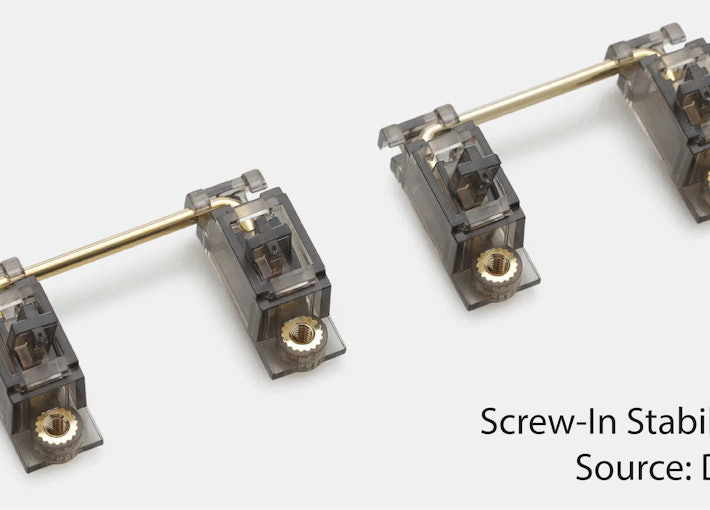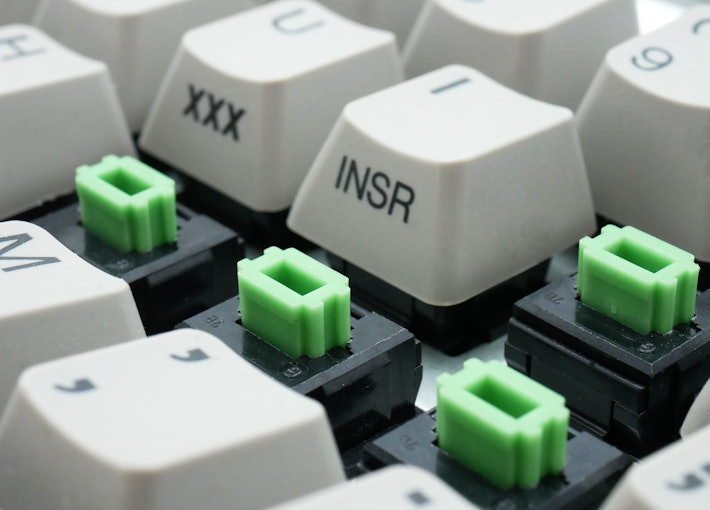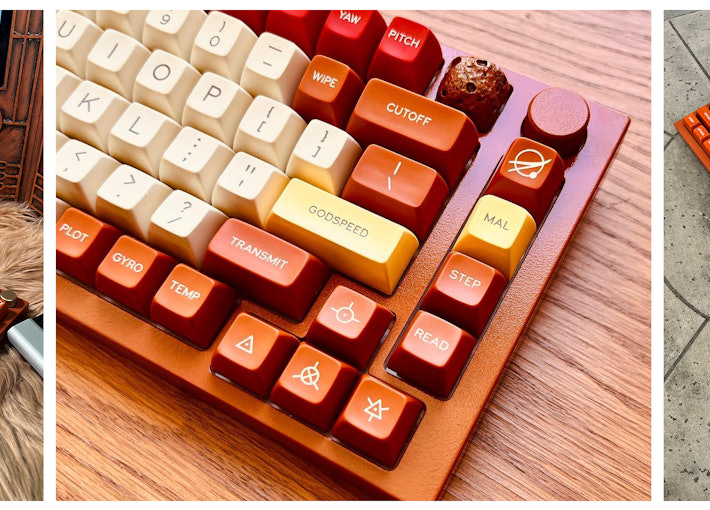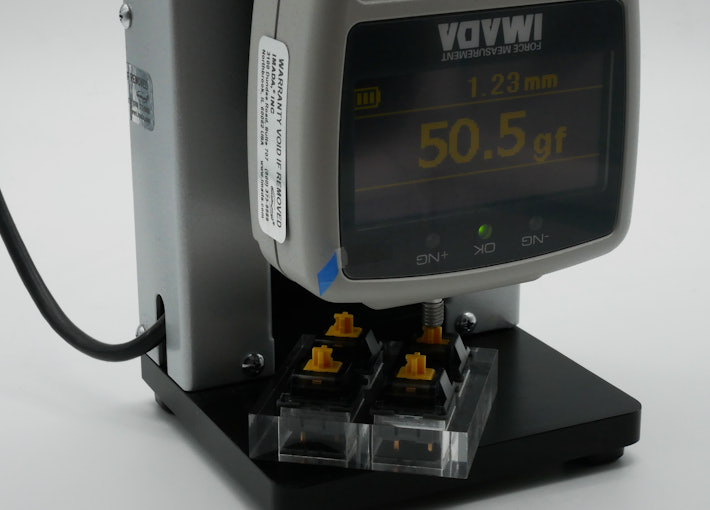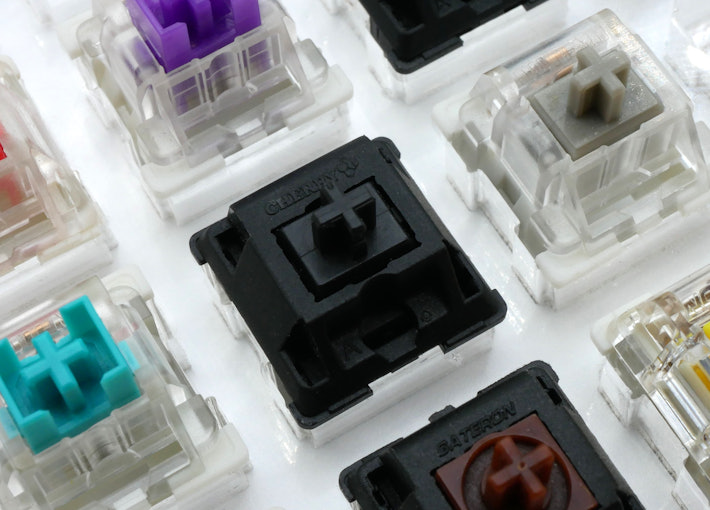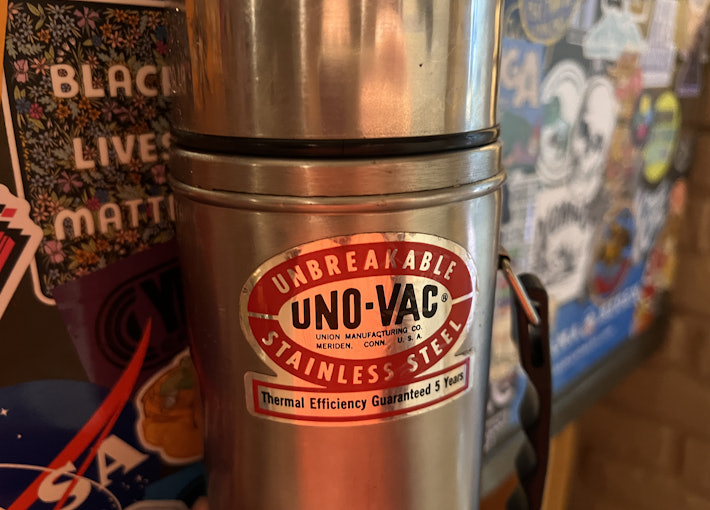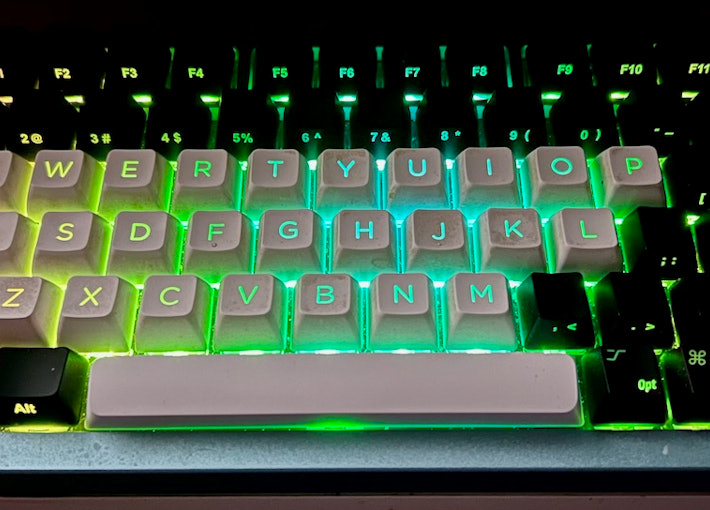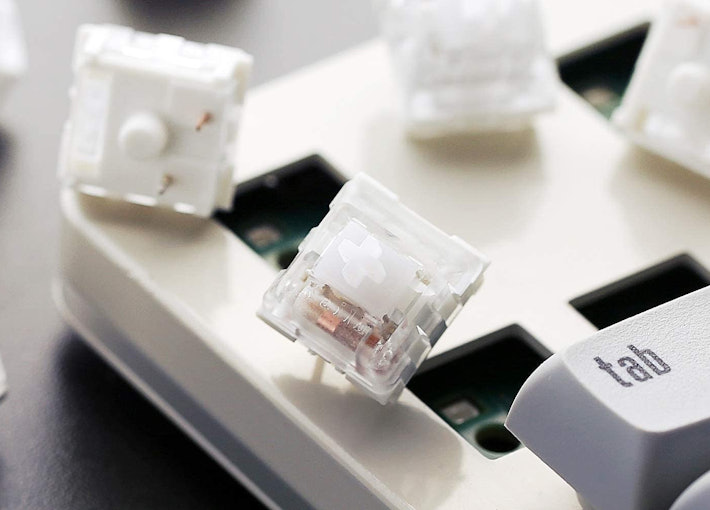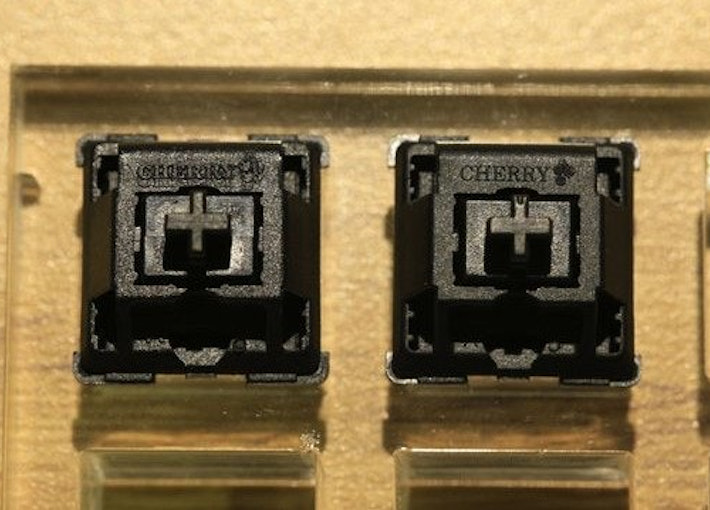Click to view our Accessibility Statement or contact us with accessibility-related questions





















All Communities
Posted in Mechanical Keyboards
ThereminGoatMK
429
Jul 23, 2024
I Think My Switch Is Stuck! - The Tale of Cherry MX Locks
Over the years of collecting mechanical keyboard switches, I’ve been lucky enough to have encountered dozens upon dozens of rare and unique ones that have stuck in my mind to this day. Prototypes, factory errors, and even a few switches so rare that there is literally zero documentation about them anywhere in the world all fill that personal list from top to bottom. However, I realize that talking about switches so far outside of most people’s reaches, and even sometimes my own grasp, doesn’t make for the most exciting of articles about switches. To this newest generation of keyboard enthusiasts, though, there is one pretty rare MX-style switch which has made its way to the top of everyone’s “must try” lists – Cherry MX Locks. These often undiscussed and even more rarely seen switches are something that few people have seen and even fewer have had the chance to try at a meetup before. However, the list of people who really know how these unique Cherry switches work is even shorter...
Posted in Mechanical Keyboards

dovenyi
61
Apr 30, 2024
What is SpaceFN and why you should give it a try
The SpaceFN concept - setting up your space key as a layer switch when held - is probably one of the most useful tweaks in the keyboard hobby. Let me explain how it works.
My SpaceFN article on kbd.news made some rounds recently - quite surprisingly given the age of this concept. This piece you're reading is a condensed version of the full post. If you're left with unanswered questions, you'll most likely find the info you're looking for in the original write-up.
On my imaginary top list of the most useful keyboard features, tweaks and hacks, SpaceFN would deserve a podium finish for sure. But what makes it so special?
In short: SpaceFN is easy to implement, easy to learn, costs nothing, can be used with any keyboard, and can improve your productivity instantly.
I will list its benefits below, but can state right at this point that the SpaceFN concept, setting up your space key as a layer switch when held, is clearly one of the most useful tweaks in the keyboard hobby....
Posted in Mechanical Keyboards

dvorcol
5393
Apr 23, 2024
Support for Alternative Layouts
This is a summary of how alternative layouts have been supported by kits such as Colevrak and Homing. It is not a discussion of alt layout performance and development, but if that interests you I highly recommend starting with Pascal Getreuer’s A guide to alt keyboard layouts (why, how, which one?). It’s a concise and comprehensive overview with links to some great sites that go deeper. He also has a separate Links about keyboards page. The Keyboard layouts doc he recommends explains layout goals and metrics in detail, summarizing the alt layouts discussed here as well as more than one hundred others.
Sculpted-profile
The majority of custom keycap sets are sculpted-profile (Cherry, SA, MT3, KAT, etc. - more on profiles generally here) so let’s start there. Because each row has a unique keycap shape, alt layouts require a unique keycap for each legend that moves off its QWERTY row.
At first there were two
The Dvorak layout was patented in 1936 by August Dvorak & William L....
Posted in Mechanical Keyboards
ThereminGoatMK
429
Apr 17, 2024
Do I Need to Lube My Keyboard Switches?
Figure 1: Sometime around here is a good time to ask that question...
If you’re new to the mechanical keyboard hobby, I have no doubt that planning your first keyboard build is a bit of a daunting task. To be entirely honest with you, it’s only a tiny bit less daunting for your second or even third keyboard builds should you stay around a little while longer. You’ve got the keyboard itself to worry about, stabilizers, keycaps, and even switches on top of all of the intangible marks you want your dream keyboard to hit. Switches are especially daunting right out of the gate as there’s just so many options out there to pick from – each with their own unique specifications, manufacturers, and more. Yet, in spite of all of these differences between switches, time and time again I find people always asking about lubing switches as one of their chief concerns when it comes to picking some up. With countless numbers of content creators talking about lubing switches, its no...
Posted in Mechanical Keyboards

HoffmanMyster
3110
Apr 9, 2024
DCX vs DCD vs DCL - Drop’s Keycap Profiles Explained
We’ve covered the basics of keycap profiles before—spherical/cylindrical, sculpted/uniform, etc. One thing that has come up more and more over the years as we’ve expanded our portfolio of offerings here at Drop is the distinction between some of our similar profiles. Specifically, what is the actual difference between DCX, DCD, and DCL?
Cylindrical Profiles
To recap the previous article on the topic, one of the most basic ways to separate various keycap profiles is by shape (cylindrical, spherical, or flat). DCX, DCD, and DCL are all cylindrical profiles.
The most famous cylindrical profile is Cherry profile, as defined by the original manufacturer of the keycaps—Cherry. GMK now owns those tools, and as such, only they can technically claim to produce “Cherry” profile keycaps. Similar keycap profiles are often called Cherry profile colloquially, but are in actuality slightly different. For the sake of not splitting hairs, all of the cylindrical profiles discussed here are...
Posted in Mechanical Keyboards
cobertt
22
Apr 2, 2024
3 or 5? How many pins does your switch really need?
One of the oldest questions, albeit one you don’t see very often anymore, is about 3-pin and 5-pin MX switches. Early in the custom switch scene, budding enthusiasts would need to determine whether their keyboard needs 3-pin or 5-pin switches. Today, the question doesn’t appear as often as it used to, but it is still important to know the difference and when one is a better choice.
The difference between these two types of switches is in the name, the number of pins. As seen in the pictures below, 3-pin switches have two metal legs for the contact leaves and registering of switch presses as well as the stem pole. These switches were traditionally called plate mount switches, as they relied on the plate to align the switches on the PCB. 5-pin switches have the same contact pins and stem pole but are also accompanied by two additional alignment pins on the left and right of the stem pole. These were called PCB mount switches, as they could be used without plates as the PCBs would...
Posted in Mechanical Keyboards
ThereminGoatMK
429
Mar 27, 2024
Mechanical Keyboard Sound Isn't That Simple
Figure 1: I couldn't think of a more literal way to represent this article if I tried...
Looking back just a few years ago, there’s no doubt that the huge influx of people that joined the hobby at the peak of the COVID pandemic were drawn to keyboards by way of YouTube, TikTok, and other audio-visual content platforms. Even as the output from these content creators has waned in recent months, their collective impact and legacy on the keyboard hobby is rather firmly etched in the history books. As a result of all of their sound tests, build logs, and opinion videos, the message is clear to any new person joining the hobby: mechanical keyboards are all about the sound. Thock this, clack that. Whether it’s keyboards, keycaps, or even singular switches, seemingly everyone new to the hobby meticulously pores over each component of their keyboard not in an attempt to figure out how it will feel in hand, but how it will sound as they’re furiously grinding their way out from...
Posted in Mechanical Keyboards

storyboardtech
417
Mar 21, 2024
Keyboards at work: A rationale for returning mechanical keyboards to the office environment.
As I walk down the hall to my office each morning, I hear the discordant clattering of keys coming from my coworker’s office. In the hall… several doors down… I hear them. Like the loose teeth in my grandma’s poodle, barely hanging on, they rattle and heave. If anyone’s ever told you that mechanical keyboards are too loud, it’s simply because that person has become completely desensitized to the garbage-bomb that is the standard office computer keyboard.
In the 1980’s and 90’s, it was common to hear the sound of unmitigated excellence when you walked into an office building. The rapid gunfire-like precision of a room full of high-quality computer keyboards firing in unison. Even in the early 2000’s when I worked in a south-side Chicago newspaper newsroom, it was still filled with such keyboards. Ten to fifteen years into their professional daily use, they were still magnificent in sound and feel. Punctual, clean, decisive. In those days, professional keyboards didn’t come...
Posted in Mechanical Keyboards
cobertt
22
Mar 5, 2024
Stabilizer Shake Down - A breakdown of modern MX-style stabilizers
One of the best parts of custom keyboards is the sound they make. It’s clean, crisp, and free from any chatter or rattles. On a well-built custom keyboard, each keystroke is solid and definitive. On the smaller keys on your keyboard, keys 1.75 units or less, you can attribute that feeling to the switches themselves. However, on larger keys, keys that are 2 units and larger, stabilizers can make or break that feeling. Today, there are a plethora of different stabilizer options available for purchase. It can be confusing trying to navigate the different brands and configurations of stabilizers. Hopefully, after reading this, you’ll have the confidence to purchase the stabilizer that fits both your budget and your needs.
Before laying out the stabilizer options, it is important to understand their function within a keyboard. Stabilizers serve two main purposes. The first is to ensure that when pressing a larger key (2 units or larger) there is consistency in the keycap press. This...
Posted in Mechanical Keyboards
ThereminGoatMK
429
Feb 28, 2024
The Vintage Switch Conundrum
Figure 1: What could be so confusing about some pretty NOS Alps SKCL Greens?
Having thoroughly beaten my opinions to death on well over a hundred different modern, MX-style switches over the past few years, one of the most common questions I get revolves around why I hardly use and/or review vintage, non-MX style switches at all. After all, the wide world of vintage mechanical keyboard switches is full of unique, odd mechanisms and “all modern switches are just recolors of each other.” While I take personal issue with that incredibly misguided second claim, I can totally understand how people can look at the wide swathes of variation in vintage switches and naturally think that that would be something I’d gravitate towards. And for what it’s worth, vintage switches are both incredibly interesting and something that I have quite a lot of hiding away in boxes. Some of my favorite brands and styles include RAFI Hall Effect switches, Hi-Tek 725s of all forms, SMK Inverse...
Posted in Mechanical Keyboards

storyboardtech
417
Feb 21, 2024
SA in 2024: Where does the high-profile king stand in the modern keyboard hobby?
In early 2021, I only had eyes for SA Godspeed.
Raised in Florida across the bay from Cape Canaveral, I grew up watching space shuttle launches, and my dad’s life-long obsession with NASA, space and sci-fi quickly spread to me. At 27, I was introduced to Neil Armstrong, a personal hero, and was able to tell him the impact he had on me and my family. So on that fateful spring day when I walked into my IT department and told my coworkers that I was thinking of getting into mechanical keyboards, the first set I wanted to own was Godspeed. It took awhile, and I mean awhile for me to accumulate all the different versions of that set. It has three alphas (Solar, Lunar and Supernova), a few full alternates (Mito & Genespeed) and several alternate modifier sets including the transcendent Ares colorway. But several hundred dollars, and many months later, I had constructed a few keyboards all equipped with different versions of SA Godspeed. I made an Earth keyboard, a Mars, an Asteroid, a...
Posted in Mechanical Keyboards
ThereminGoatMK
429
Jan 23, 2024
An Introduction To Force Curves
Figure 1: My Imada force gauge machine gifted to me by Drop mid-collection of a Drop Holy Panda X force curve.
Over the course of the last year or so of writing switch reviews of my own, I’ve been integrating more and more data into my descriptions and comparisons of switches. This is seen no more clearly than in the dozens of wiggly-lined graphs, known as ‘Force Curves’, that now sprout up in the dozens on each of my latest reviews. While I’ve managed to avoid dragging the discussion of force curves into any of my short articles on Drop thus far, the increasing use of them throughout my work means I should probably get around to discussing them sometime soon. After all, while I live and die by this kind of information for switches, I fully well understand that I am more obsessed about switches than the vast majority of (admittedly kind of already weird) mechanical keyboard enthusiasts. However, I think that knowing a thing or two about force curves could make a big...
Posted in Mechanical Keyboards
ThereminGoatMK
429
Dec 13, 2023
What Even Are "OEM" Switches?
The secret bedrock of any technology-heavy hobby is a whole bunch of slang and jargon that makes it feel borderline like a second language to outsiders listening in on discussions about the hobby. Mechanical keyboards are, much to your surprise I’m sure, no exception to that rule. Unfortunately, having been around for as long as I have been, I’ve become a bit of the problem and have found myself casually shooting acronyms and concepts way above my friends and coworkers heads as I talk to them about keyboards. Equally as disappointing of me is that this has also seeped into my content, as well. In fact, as I was looking through some of my old writing the other day, I realized that I have eternally used one phrase - “OEM” - without ever actually elaborating on what explicitly I mean by such in the broader context of mechanical keyboard switches. While I get that it feels really basic and easy for many people who have been deep in the hobby for some time to kind of understand...
Posted in Mechanical Keyboards
TBNRnooch
10
Nov 29, 2023
Don't Buy A Mechanical Keyboard... Yet
My mechanical keyboard journey started when I fell into the rabbit hole around August 2020. Since then, I have tested over forty different switches, built or modified over twenty keyboards, and experimented with many different layouts. I usually carry a mechanical keyboard with me, and have built keyboards for friends and family members. Many consider mechanical keyboards superior to normal membrane keyboards due to their feel, sound, looks, layout options, software, and various customization options. While many swear by mechanical keyboards, they are expensive, and the landscape of mechanical keyboards is confusing and hard to navigate. That said, if you do decide to look into and possibly build one, here is some more information to guide you through the rabbit hole.
The first thing you will probably notice while looking through videos about mechanical keyboards is the sound. Many people build their custom keyboards with sound in mind, and because of this there are endless jargon...
Posted in Battlestations

storyboardtech
417
Nov 9, 2023
Balancing act: crafting authentic deskscapes
My grandpa was a truck driver for 40 years, and in that time he used two thermoses. I own them both, and the smaller of the two, which was clearly used on hundreds of runs, has a scratched and faded line of text below the label that reads “Thermal Efficiency guaranteed 5 years.” It might as well have said “105 years” because it works as well today as the day he bought it. That thermos is incredibly well designed, well made, and I assume it will work for another 50 years unless something drastic happens to it.
You’ll often hear people say “they don’t make things like they used to” and in my experience, that’s largely true. Products in the past were often made with longevity in mind, and to be honest, it was easier to build them so sturdy back then. Tools weren’t computerized, the parts weren’t as tiny, and the types of metal and plastic they were made from were costly and often machined with a human involved in the process.
I adore technology and surround my desktop space...
Posted in Mechanical Keyboards
ThereminGoatMK
429
Nov 1, 2023
About That List of Every Switch Ever…
Figure 1: While this is a good start from user destohfaeda, this isn't anywhere near complete...
After having collected switches for almost five consecutive years now, I can say with confidence that everything switch related comes and goes in ever-looping cycles. Strong tactile bumps towards the start of the downstroke were once novel and popular, faded out of the limelight over the past few years, and are only just now starting to make a comeback. Huge leaps in housing aesthetics happened back when the first custom colored MX-style switches began being offered in 2018, and now five years later these massive leaps in design capabilities are surging again. Even things contextually related to switches rotate around and around in cycles. One such switch-related phenomenon which repeats in a (much faster) loop is that of people wanting to make a complete list of “every switch ever”. Almost on a monthly basis for every single month since I started collecting, at least one new...
Posted in Mechanical Keyboards

Kenshiro70
137
Oct 18, 2023
Getting good backlighting with CSTM and other south-mount keyboards
Drop's had a pretty good history of creating RGB-friendly keyboards. But even with the new south-mount CSTM keyboard line, it is possible to set up a reasonable backlit solution.
Level-set
Just to get everyone on the same page, "north-mount" LEDs refers to LEDs positioned at the top of the switch socket, which requires mounting the switch with the LED "window" on top and the pins towards the bottom of the keyboard. With certain switches and keycaps, the keycap can contact the top of the switch, resulting in a bad typing feel.
"South-mount" switches have the LED on the bottom, allowing the switch the be rotated 180 degrees, with LED window on the bottom and pins on the top. This avoids the contact problem. These days, many switches have a shortened or hollow LED window, sidestepping the contact problem, but there is still a general preference towards south-mount.
The Problem
Due to its "g4m3r" keyboard history, RGB backlighting has long had a bad rep with serious...
Posted in Mechanical Keyboards

storyboardtech
417
Oct 5, 2023
In defense of MT3, the most misunderstood and possibly greatest keycap profile.
Offices are tense spaces, there’s no way around it. Whether they’re silent, museum-like tombs or raucous zoos filled with energy. In this place of distraction, and often discomfort, it’s important to have tools that make you more efficient, comfortable and focused. Personally, I am lucky to work in a happy, healthy work environment with amazing coworkers, but my office is filled with distraction and on my best days it’s a challenging ecosystem in which to create.
I’ll be honest, I’m no gamer, and it wasn’t the speedy, silent linear switches or 8000Hz polling rates of gaming boards that drew me to this hobby. It was the spirit of clickety-clackety typewriters of the past and a desire to craft my words on a surface that deserved them… one that amplified my ideas and provided a comfy ambience that encouraged creativity.
I don’t feel old, and certainly don’t act old, but I’ve been a designer for 25 of my 43 years and in that whole time I’ve hated the keyboards I’ve used. With the...
Posted in Mechanical Keyboards
ThereminGoatMK
429
Sep 27, 2023
We Know Nothing About Switch Materials
Figure 1: A fantastic Kailh switch photo from Blitzenx51!
There’s any number of different details people look into when they’re trying to pick out switches for their next keyboard build. However, arguably none of them are as vague and mysterious as the materials used to make housings and stems. Yes, even as manufacturers are iffy about their spring weights and newer brands are sketchy about who actually made their switches, differentiating POM from Nylon from Polycarbonate remains to this day the least understood parts of mechanical keyboard switches. For what it’s worth, I don’t have a fix for that either. As someone who has completed a master’s degree in chemical engineering focusing on polymer science, I understand full well that attempting to reverse engineer the formulas of even the most simple keyboard switch materials would take months on end and nearly free-range access to numerous analytical instruments that companies simply won’t hand over to you. However, that...
Posted in Mechanical Keyboards
ThereminGoatMK
429
Aug 15, 2023
Switch Myths That Aren't Actually True!
As someone who has been writing documentation in the mechanical keyboard hobby space for many years now, I can say with utter confidence that there’s a lot of misinformation still floating around the hobby today. While some portion of these claims and community-wide thoughts can be traced back to dubious videos or posts that may as well have been carved into stone line by line, a good amount of the strange ideas still permeating throughout the hobby have come passed down in the form of community wisdom. Surely you recall your friend who got you into keyboards telling you to ‘Just do X’ or ‘Stay away from Y because of Z’, right? More likely than not, that is the same wisdom that their friend who got them into the hobby first shared with them several years ago. As you can probably put together, this mechanical keyboard-themed telephone game has led to quite some prolific ideas being spread over the years that are completely detached from reality. These tall tales, blatant lies, and...
















